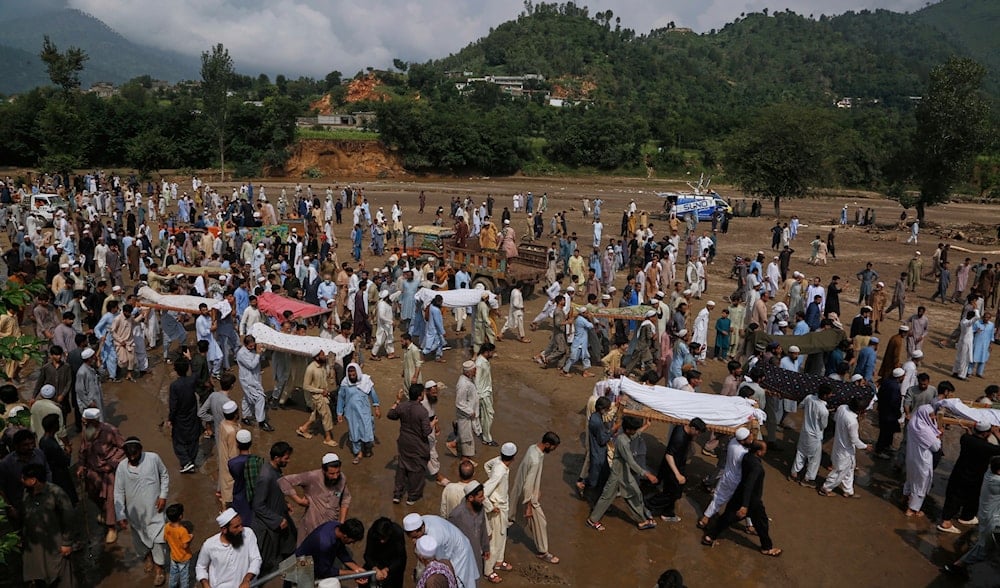Over 150 missing in Northwest Pakistan after monsoon rains
At least 344 people have died and more than 150 remain missing after devastating floods hit Khyber Pakhtunkhwa, Pakistan.
-

People carry bodies of the victims of Friday's flash flooding, after funeral prayers at a village near Pir Baba, Buner district, in Pakistan's northwest, Saturday, Aug. 16, 2025. (AP Photo/Muhammad Sajjad)
More than 150 people remain missing in northwest Pakistan after flash floods triggered by heavy monsoon rains swept through the region, according to the provincial disaster authority, as the death toll across the country has risen to at least 344.
Thousands of rescuers are wading through mud and debris in Khyber Pakhtunkhwa, desperately searching for survivors. Entire homes have been crushed under boulders, with families feared trapped beneath the rubble or swept away by floodwaters.
Heavy rains and severe flooding in Pakistan have left hundreds of homes submerged and families stranded on rooftops.pic.twitter.com/WCqyfiowNw
— Massimo (@Rainmaker1973) August 15, 2025
“In Buner, at least 150 people are still missing. They could be trapped under the rubble of their homes or swept away by floodwaters,” said Asfandyar Khattak, head of the Khyber Pakhtunkhwa Provincial Disaster Management Authority, in a statement to the AFP. “Separately, in Shangla district, dozens of people are also reported missing.”
The mountainous district of Buner has suffered the heaviest losses, with at least 208 confirmed deaths. According to a provincial rescue spokesman, “10 to 12 entire villages” have been partially buried by landslides and mudflows, per AFP.
Rescue operations impeded
Relief operations have been hampered by ongoing rain and extensive damage to infrastructure. “There is no electricity or mobile signal in Buner, as power lines and mobile towers were damaged in the flash floods,” Khattak told the AFP.
Bilal Ahmed Faizi, spokesperson for the provincial rescue agency, confirmed that around 2,000 rescue workers are engaged in operations across nine districts, but continuous rainfall is hindering efforts.
Flood situation in Buner, Pakistan pic.twitter.com/F8STsfY55B
— Discover Pakistan 🇵🇰 | پاکستان (@PakistanNature) August 15, 2025
The search for missing people in Buner and Shangla remains the top priority, with authorities fearing the numbers could rise further as communication lines are restored and more remote areas become accessible.
Teams are working day and night to recover bodies and provide relief to displaced families, but the scale of the disaster and the harsh terrain are slowing progress. Officials warn that if the rains continue, further landslides and flash floods could complicate rescue missions.
Pakistan’s deadly Monsoon floods
The current disaster is part of a larger crisis sweeping northern Pakistan. Since the monsoon season began on June 26, 2025, at least 645 people have been killed nationwide, with over 1,676 buildings damaged and 562 completely destroyed. Livestock losses and severe disruption to mountain communities have compounded the suffering.
Within Khyber Pakhtunkhwa Province, the hardest-hit districts include Buner, Swat, Bajaur, Shangla, Mansehra, Battagram, and Lower Dir, all declared disaster-hit zones. The Pakistani military has deployed helicopters and boats to reach stranded residents, while over 2,000 people, including 300 schoolchildren, were evacuated in Buner alone.
Tragedy also struck rescue operations when a Pakistani military Mi-17 helicopter crashed during relief missions, killing all five crew members on board. The provincial government declared a day of mourning to honor the fallen rescue personnel.
Massive flash flood in Gulmit Gojal, upper Hunza Gilgit Baltistan, Pakistan today 👀 pic.twitter.com/TmOcyF9waz
— Volcaholic 🌋 (@volcaholic1) August 12, 2025
Pakistan disproportionately affected by climate change
The devastating floods highlight Pakistan’s extreme vulnerability to climate change. Studies show rainfall in Pakistan was 10–15% heavier due to climate change, amplifying the destruction caused by seasonal monsoons.
Pakistan contributes less than 1% of global greenhouse gas emissions, yet consistently ranks among the world’s top 10 most climate-vulnerable countries. The Climate Risk Index 2025 even placed Pakistan as the most affected country worldwide based on 2022 data, largely due to catastrophic economic losses from climate disasters.
The country is also facing one of the world’s worst water crises, with per capita availability dropping below 1,000 cubic meters in 2023, officially placing it in the category of “water-scarce nations.” Projections suggest this could fall to 860 cubic meters by 2025, severely threatening agriculture and food security.
Climate change has already disrupted Pakistan’s crop cycles, with wheat and rice yields falling significantly in recent years. Economic losses from climate-induced agricultural decline are projected to reach $19.5 billion by 2050. The World Bank has further warned that climate change could shrink Pakistan’s GDP by 18–20% by mid-century.
Despite these challenges, Pakistan has set ambitious climate goals, including cutting projected emissions by 50% by 2030 and transitioning to 60% renewable electricity. Yet, without substantial international support, experts warn Pakistan faces a worsening cycle of climate-driven disasters.

 4 Min Read
4 Min Read










